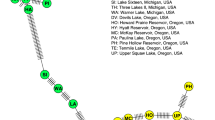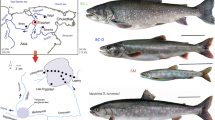Abstract
The Eurasian freshwater tubenose goby Proterorhinus semilunaris (formerly Proterorhinus marmoratus) invaded the Laurentian Great Lakes in the 1990s, presumably via ballast water from transoceanic cargo ships. Tubenose gobies spread throughout Lake St. Clair, its tributaries, and the Detroit River system, and also are present in the Duluth-Superior harbor of Lake Superior. Using seines and bottom trawls, we collected 113 tubenose gobies between July 2007 and August 2009 at several locations in western Lake Erie. The number and range of sizes of specimens collected suggest that that tubenose gobies have become established and self-sustaining in the western basin of Lake Erie. Tubenose gobies reached maximum densities in sheltered areas with abundant macrophyte growth, which also is their common habitat in native northern Black Sea populations. The diet of tubenose gobies was almost exclusively invertebrates, suggesting dietary overlap with other benthic fishes, such as darters (Etheostoma spp. and Percina sp.), madtoms (Noturus spp.), and sculpins (Cottus spp.). A single mitochondrial DNA haplotype was identified, which is the most common haplotype found in the original colonization area in the Lake St. Clair region, suggesting a founder effect. Tubenose gobies, like round gobies Neogobius melanostomus, have early life stages that drift owing to vertical migration, which probably allowed them to spread from areas of colonization. The Lake St. Clair-Lake Erie corridor appears to have served as an avenue for them to spread to the western basin of Lake Erie, and abundance of shallow macrophyte-rich habitats may be a key factor facilitating their further expansion within Lake Erie and the remainder of the Laurentian Great Lakes.

Similar content being viewed by others
References
Adamek Z, Andreji J, Gallardo JM (2007) Food habits of four bottom-dwelling gobiid species at the confluence of the Danube and Hron rivers (South Slovakia). Int Rev Hydrobiol 92(4–5):554–563
Balon EK (1975) Reproductive guilds of fishes: a proposal and definition. J Fish Res Board Can 32:821–864
Brown JE, Stepien CA (2009) Invasion genetics of the round goby: tracing Eurasian source populations to the New world. Mol Ecol 18:64–79
Bunnell DB, Johnson TB, Knight CT (2005) The impact of introduced round gobies (Neogobius melanostomus) on phosphorus cycling in central Lake Erie. Can J Fish Aquat Sci 62:15–29
Carman S, Janssen J, Jude DJ, Berg M (2006) Diel interactions between prey behaviour and feeding in an invasive fish, the round goby, in a North American river. Freshwater Biol 51(4):742–755
Dopazo SN, Corkum LD, Mandrak NE (2008) Fish assemblages and environmental variables associated with gobiids in nearshore areas of the lower Great Lakes. J Great Lakes Res 34:450–460
Economidis PS (1995) Endangered freshwater fishes of Greece. Biol Cons 72(2):201–211
Erös T, Sevcsik A, Tóth B (2005) Abundance and night-time habitat use patterns of Ponto-Caspian gobiid species (Pisces, Gobiidae) in the littoral zone of the River Danube, Hungary. J Appl Ichthyol 21:350–357
French JRP III, Jude DJ (2001) Diet and diet overlap of non-indigenous gobies and small benthic native fishes co-inhabiting the St. Clair River, MI. J Great Lakes Res 27:300–311
Gray EvS, Bolz JM, Kellogg KA, Stauffer JR Jr (1997) Food resource partitioning by nine sympatric darter species. Trans Am Fish Soc 126:822–840
Greenberg LA (1991) Habitat use and feeding behavior of thirteen species of benthic stream fishes. Env Biol Fish 31:389–401
Hensler SR, Jude DJ (2007) Diel vertical migration of round goby larvae in the Great Lakes. J Great Lakes Res 33:295–302
Holeck KT, Mills EL, MacIsaac HJ, Dochoda MR, Colautti RI, Ricciardi A (2004) Bridging troubled waters: biological invasions, transoceanic shipping, and the Laurentian Great Lakes. Bioscience 54:919–929
Holland RE (1993) Changes in planktonic diatoms and water transparency in Hatchery Bay, Bass Island area, western Lake Erie since the establishment of the zebra mussel. J Great Lakes Res 19:617–624
Hubbs CL, Lagler KF, Smith GR (2004) Fishes of the Great Lakes Region. The University of Michigan Press, Ann Arbor
Jude DJ, DeBoe SF (1996) Possible impact of gobies and other introduced species on habitat restoration efforts. Can J Fish Aquat Sci 53(Suppl. 1):136–141
Jude DJ, Reider RH, Smith GR (1992) Establishment of Gobiidae in the Great Lakes Basin. Can J Fish Aquat Sci 49:416–421
Jude DJ, Janssen J, Crawford G (1995) Ecology, distribution, and impact of the newly introduced round tubenose gobies on the biota of the St. Clair and Detroit rivers. In: Munawar M, Edsall T, Leach J (eds) The Lake Huron Ecosystem: Ecology, Fisheries, and Management. Academic Publishing, Amsterdam
Kocovsky PM, Edwards WH, Porta MJ, Stapanian MA, Bur MT (2009) Spring and autumn fish density, biomass, and diets in Michigan and Ontario waters of the western basin of Lake Erie. USGS Lake Erie Biological Station, Report to the Standing Technical Committee of the Lake Erie Committee, Great Lakes Fishery Commission, Romulus, Michigan 13pp
Leslie JK, Timmins CA, Bonnell RG (2002) Postembryonic development of the tubenose goby Proterorhinus marmoratus Pallas (Gobiidae) in the St. Clair River/Lake system, Ontario. Arch Hydrobiol 154:341–352
Mills EL, Leach JH, Carlton JT, Secor CL (1993) Exotic species in the Great Lakes: a history of biotic crises and anthropogenic introductions. J Great Lakes Res 19:1–54
Neilson ME, Stepien CA (2009) Evolution and phylogeography of the tubenose goby genus Proterorhinus (Teleostei: Gobiidae): evidence for new cryptic species. Biol J Linn Soc 96:664–684
Pinchuk, VI, Vasil’eva ED, Vasil’ev VP, Miller PJ (2004) Proterorhinus marmoratus (Pallas 1814). In: Miller PJ (ed) The Freshwater Fishes of Europe, vol 8/II. Aula Verlag, Wiebelsheim pp 72–93
Reid SM, Mandrak NE (2008) Historical changes in the distribution of threatened channel darter Percina copelandi in Lake Erie with general observations on the beach fish assemblage. J Great Lakes Res 34:324–333
Ricciardi A, MacIsaac HJ (2000) Recent mass invasion of the North American Great Lakes by Ponto-Caspian species. Trends Ecol Evolut 15:62–65
Roseman EF, Jude DJ, Raths M, Coon T, Taylor WW (1998) Occurrence of the deepwater sculpin (Myoxocephalus thompsoni) in western Lake Erie. J Great Lakes Res 24:479–483
Schloesser DW, Manny BA (2007) Restoration of Wildcelery, Vallisneria americana Michx., in the Lower Detroit River of the Lake Huron-Lake Erie Corridor. J Great Lakes Res 33(Suppl):8–19
Stapanian MA, Kocovsky PM, Adams JV (2009) Change in diel catchability of young-of-year yellow perch associated with establishment of dreissenid mussels. Freshwater Biol 54:1593–1604
Stepien CA, Tumeo MA (2006) Invasion genetics of Ponto-Caspian gobies in the Great Lakes: a “cryptic” species, absence of founder effects, and comparative risk analysis. Biol Invas 8:61–78
Stepien CA, Brown JE, Neilson ME, Tumeo MA (2005) Genetic diversity of invasive species in the Great Lakes versus their Eurasian source populations: insights for risk analysis. Risk Anal 25:1043–1060
Trautman MB (1957) The Fishes of Ohio. Ohio State University Press, Columbus
Vanderploeg HA, Nalepa TF, Jude DJ, Mills EL, Holeck KT, Leibig JR, Grigorovich IA, Ojaveer H (2002) Dispersal and emerging ecological impacts of Ponto-Caspian species in the Laurentian Great Lakes. Can J Fish Aquat Sci 59:1209–1228
Wiesner C (2005) New records of non-indigenous gobies (Neogobius species) in the Austrian Danube. J Appl Ichthyol 21:324–327
Zitek A, Schmutz S, Ploner A (2004) Fish drift in a Danube sidearm-system: II. Seasonal and diurnal patterns. J Fish Biol 65:1339–1357
Acknowledgments
We thank The Ohio State University Stone Laboratory personnel for their assistance in providing transportation to North and Middle Bass Islands for seining and John Gannon for assistance with seining. We thank Fred Snyder, Steven Gratz, and Ben Dieffenbaher for saving tubenose gobies from their seining activities around Gibraltar Island. Constructive reviews were provided by Carey Knight, Maureen Walsh, and two anonymous reviewers. Assistance with vessel operations and trawling was provided by Tim Cherry, Dale Hall, and Mike Porta. The genetic portion of this research was supported by U.S. Environmental Protection Agency #CR-83281401-0 and National Science Foundation #DEB-0456972 to CAS. This article is Contribution 1623 of the U.S. Geological Survey Great Lakes Science Center and Contribution 2011-01 from the Lake Erie Research Center.
Author information
Authors and Affiliations
Corresponding author
Rights and permissions
About this article
Cite this article
Kocovsky, P.M., Tallman, J.A., Jude, D.J. et al. Expansion of tubenose gobies Proterorhinus semilunaris into western Lake Erie and potential effects on native species. Biol Invasions 13, 2775–2784 (2011). https://doi.org/10.1007/s10530-011-9962-5
Received:
Accepted:
Published:
Issue Date:
DOI: https://doi.org/10.1007/s10530-011-9962-5




